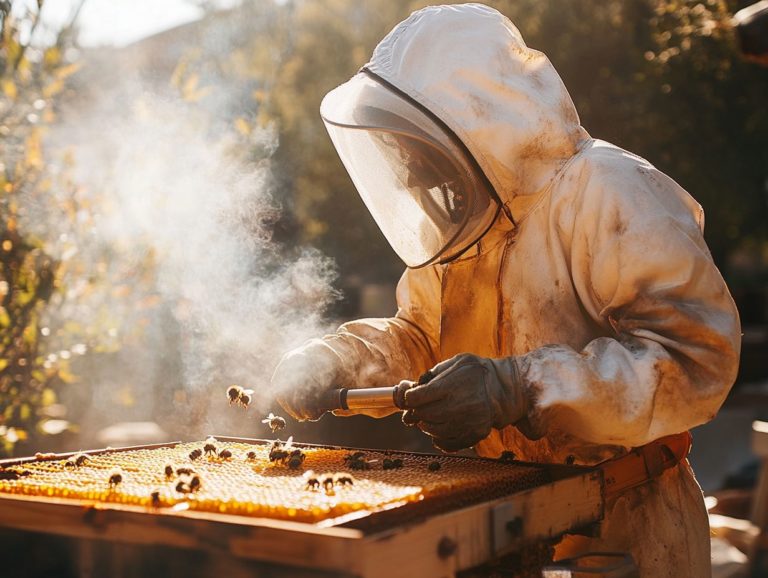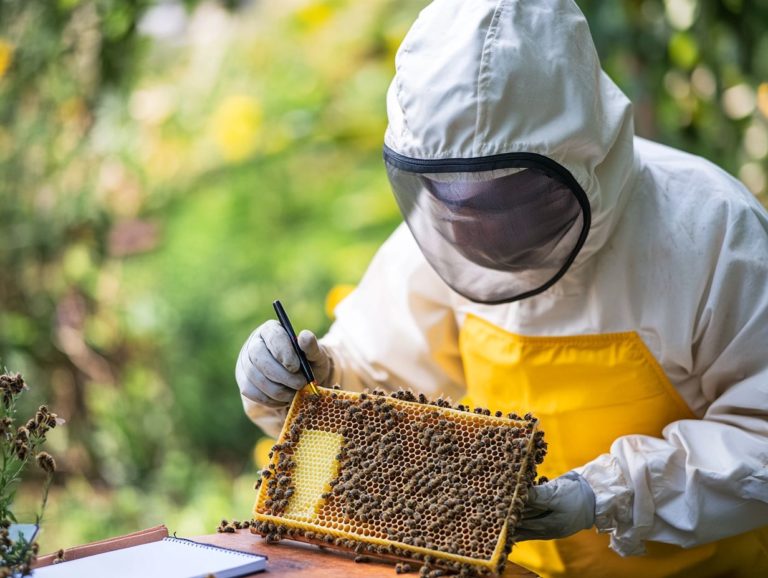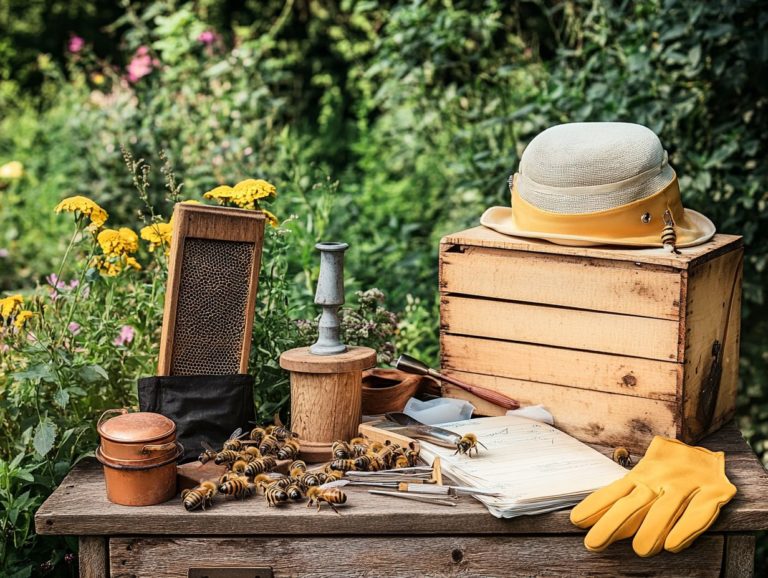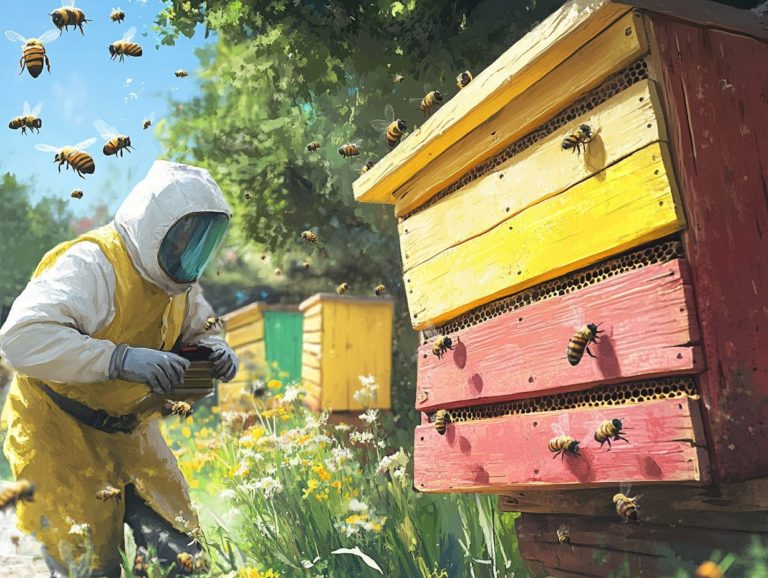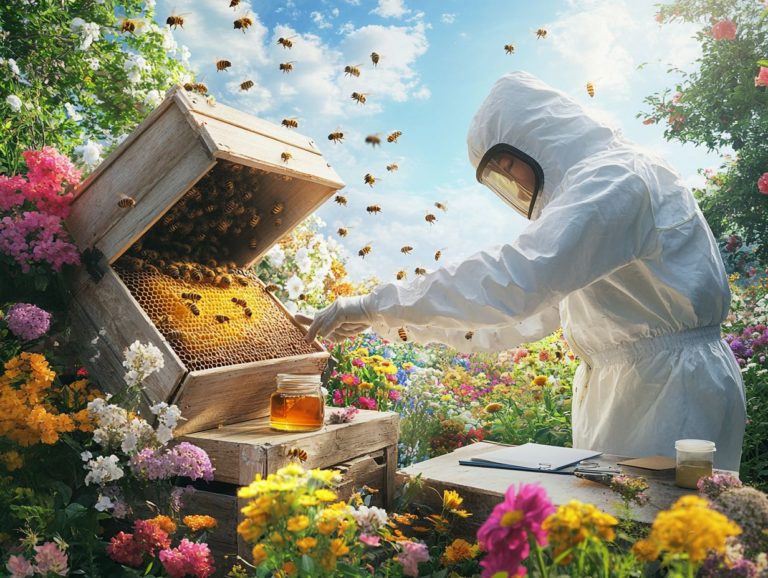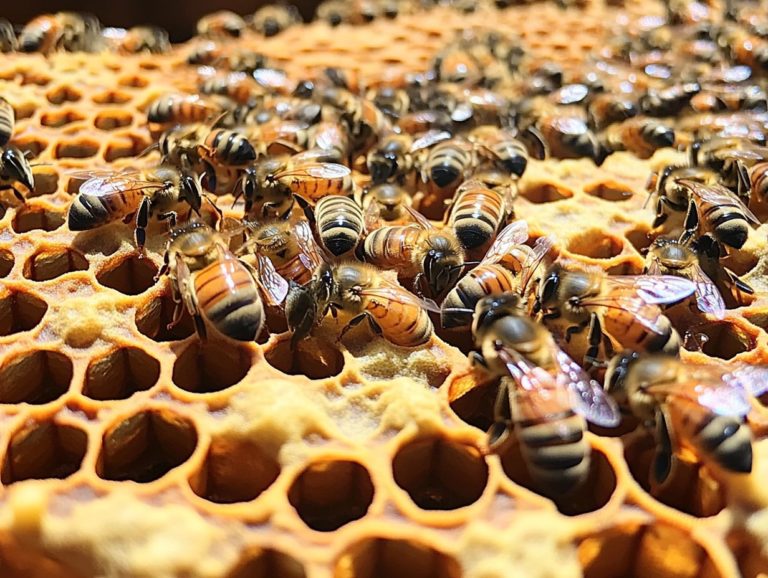How to Encourage Bee Foraging
Bee foraging is not just a captivating activity; it s an essential one that underpins the delicate balance of our ecosystem. Imagine hard-working bees, including honey bees and solitary bees, diligently seeking out nectar and pollen from vibrant flowers. This process is vital for sustaining their colonies and facilitating the pollination of the plants you rely on for nourishment.
Understanding the significance of bee foraging, the various factors that influence it, and how you can encourage these industrious pollinators is crucial for preserving biodiversity. This article delves into the intricacies of bee foraging, highlighting its myriad benefits and offering practical steps to support these remarkable creatures, including monolectic bees (bees that only gather food from one type of flower) and polylectic bees (bees that collect food from many different types of flowers), in your gardens and communities.
Your actions can make a real difference for bees! Discover how!
Contents
- Key Takeaways:
- What Is Bee Foraging?
- Why Is Bee Foraging Important?
- What Are the Factors That Affect Bee Foraging?
- How Can You Encourage Bee Foraging?
- What Are the Best Plants for Bee Foraging?
- Frequently Asked Questions
- What is bee foraging and why is it important?
- How can I encourage bee foraging in my garden?
- What are some examples of bee-friendly flowers?
- Why is it important to provide a water source for bees?
- Can I still use pesticides in my garden if I want to encourage bee foraging?
- Are there any other ways I can support bee foraging besides planting flowers?
Key Takeaways:
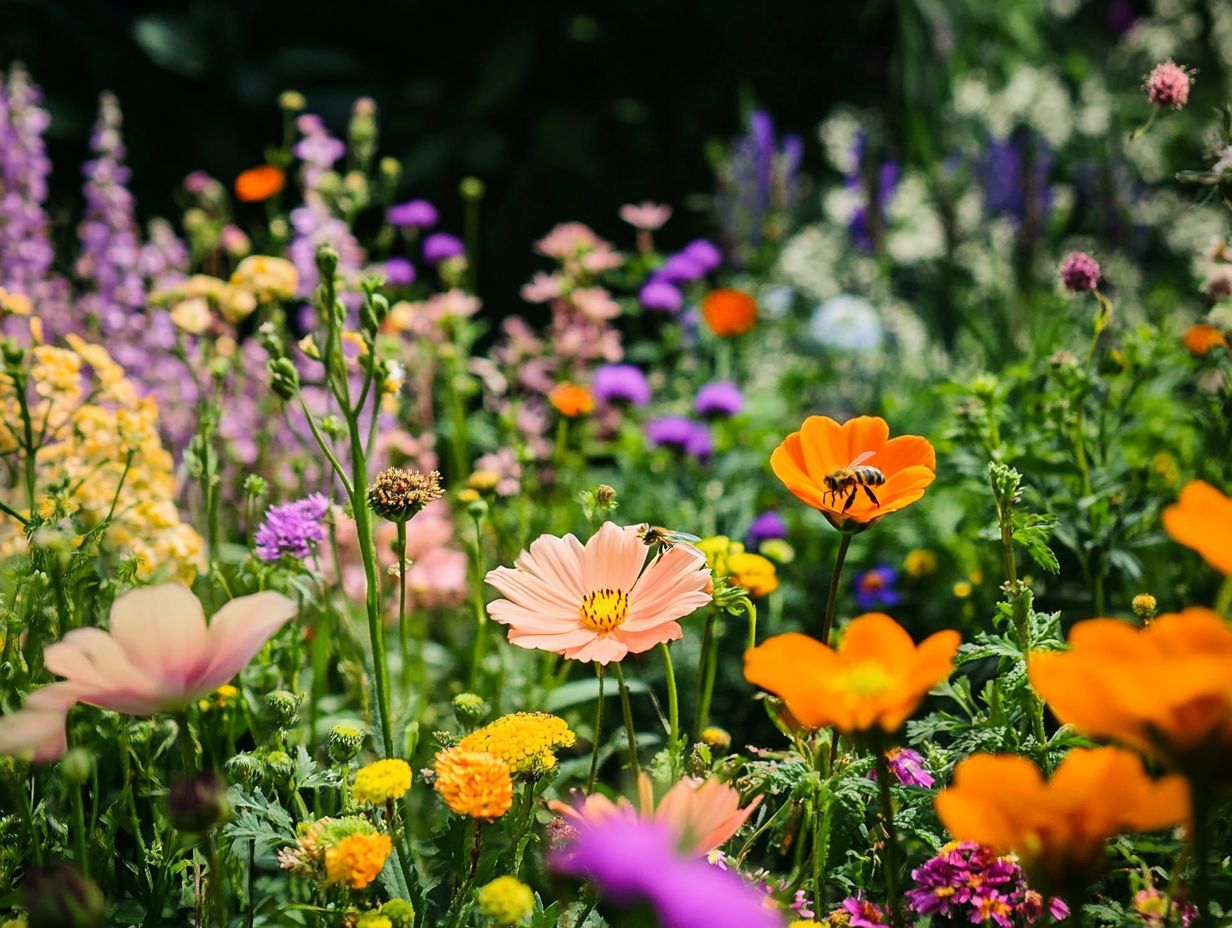
- Plant bee-friendly flowers to attract and provide food for bees.
- Provide a water source for bees to quench their thirst.
- Avoid pesticides and chemicals to protect bees and their habitats.
What Is Bee Foraging?
Bee foraging is an essential behavior that you ll observe in honey bees, especially the hard-working worker bees. As they embark on their foraging journeys, these remarkable insects gather vital nectar and pollen from a diverse array of food sources, including flowering plants such as berry plants, fruit trees, herbs, and vegetable plants.
During these excursions, bees communicate their discoveries to the rest of the hive through intricate methods like the waggle dance. This fascinating display allows them to adjust their foraging strategies based on external influences, food availability, and the types of plants in bloom.
This process not only nourishes the queen brood with necessary nutrients but also plays a crucial role in maintaining the overall health of the bee pasture and ecosystem. It underscores the significance of strategic plant selection on your part as a beekeeper, enhancing foraging efficiency, navigating potential foraging challenges, and supporting the foraging habits of different bee species.
Why Is Bee Foraging Important?
Bee foraging is essential to the health of ecosystems and agriculture. As a crucial pollinator, the honey bee particularly the worker bee plays a vital role in the reproduction of flowering plants through its diligent collection of nectar and pollen. This activity not only secures the survival of various plant species but also supports the food resources necessary for other wildlife, thereby maintaining biodiversity. Additionally, queen bees and their brood depend on these resources for their development and survival.
The foraging behavior of bees directly influences crop yields and quality. This highlights the essential role of beekeepers in sustaining bee populations and promoting bee-friendly plants such as annual plants and perennial flowers that enhance foraging success across different environments.
What Are the Benefits of Bee Foraging?
The benefits of bee foraging go well beyond simply satisfying the immediate needs of honey bees; their efforts play a crucial role in enhancing agricultural productivity and ecological health. As you witness these hard-working creatures efficiently collecting nectar and pollen through nectar foraging and pollen foraging, you’ll appreciate how they significantly boost the pollination of numerous crops, resulting in increased yields and improved quality of produce.
This not only supports the growth of bee-friendly plants but also promotes biodiversity, cultivating a balanced ecosystem that sustains a variety of species and enriches food resources for both wildlife and humans alike.
The intricate connection between bee foraging and agricultural systems does more than just elevate crop production; it also helps mitigate the impacts of climate change by nurturing resilient ecosystems. As these pollinators navigate through diverse plant species, they promote genetic diversity, enabling crops to adapt to shifting environmental conditions.
This adaptability is essential for maintaining a steady supply of various food resources, which is vital for promoting nutritional health within communities.
Ultimately, the positive effects of bee foraging ripple throughout the environment, highlighting the necessity of preserving these remarkable insects as essential contributors to a sustainable future.
What Are the Factors That Affect Bee Foraging?
Several key factors profoundly influence bee foraging behavior, shaping how honey bees, especially worker bees, collect nectar and pollen from their surroundings during their foraging trips.
Environmental conditions, including weather patterns and seasonal variations, are pivotal in determining food availability and the types of plants that bloom. These elements directly affect the foraging trips undertaken by the bees.
Moreover, challenges such as the presence of predators and competition for resources can disrupt foraging efficiency. This situation highlights the necessity for effective hive communication strategies, allowing bees to adapt and optimize their foraging efforts, ultimately ensuring the health and vitality of the entire colony.
1. Weather Conditions
Weather conditions play a crucial role in determining your honey bees’ foraging success. These industrious pollinators rely on favorable circumstances to efficiently gather nectar and pollen from flowering plants. Elements like temperature, humidity, and precipitation directly influence food resource availability, impacting how often and how long your bees venture out on foraging trips.
When the weather is just right, your bees can truly thrive, maximizing their foraging efforts. However, adverse conditions can limit their activities and jeopardize the health of your hive.
Temperature changes can dictate the blooming cycles of various plants, which in turn affects nectar availability. For instance, when temperatures rise, flowers may bloom earlier, giving your bees a head start in their foraging endeavors.
On the flip side, excessive rainfall creates a challenging environment, making it difficult for your bees to find suitable foraging sites and increasing the risk of diseases within the colony.
These fluctuations in weather not only threaten your bees’ immediate access to food but can also have cascading effects on pollination services and biodiversity. This ultimately underscores the intricate connections between bee health and the broader ecosystems they support.
2. Availability of Nectar and Pollen Sources and Plant Selection
The availability of nectar and pollen sources is absolutely crucial for the success of your foraging bees, especially honey bees, as it directly impacts their ability to meet the nutritional needs of the colony. A diverse array of bee-friendly plants in your surroundings provides the essential food resources that enable bees to forage effectively for both nectar and pollen, supporting their adaptive strategies in varying environments.
When these sources are plentiful, bees can optimize their foraging trips, ensuring the health and vitality of the hive while also contributing positively to the overall ecosystem.
In fact, a variety of flowering plants think clover, wildflowers, and fruit trees are natural magnets for bees, supporting their foraging behavior. By cultivating landscapes rich in these species, you can create environments that not only sustain your colonies but also enhance biodiversity.
Encouraging native plants, providing continuous blooms throughout the seasons, and minimizing pesticide use are all practical strategies that promote healthier bee populations. By fostering a blend of annuals and perennials, you can extend the foraging season, guaranteeing that bees have consistent access to vital resources year-round, thereby supporting their essential role in pollination and food production.
3. Presence of Predators
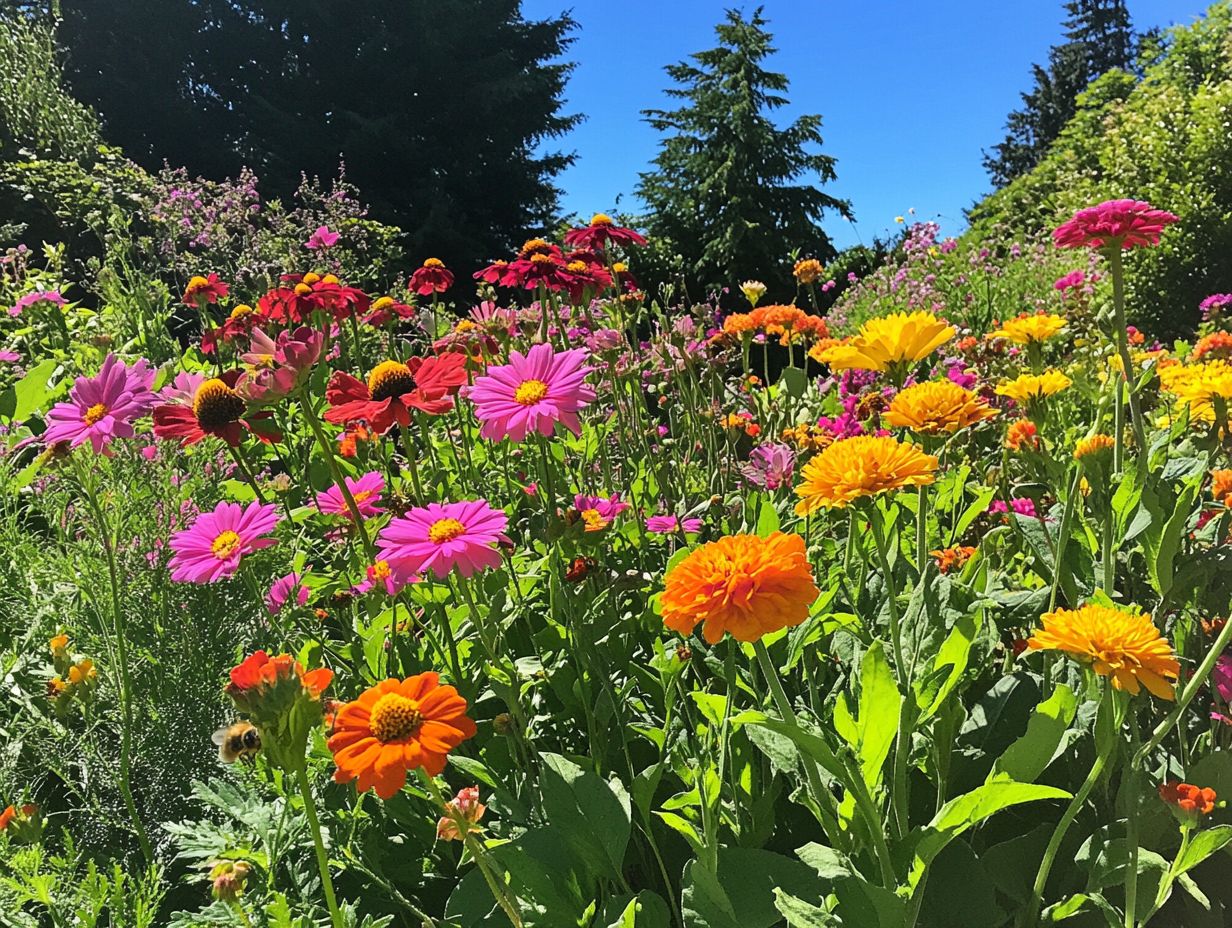
Predators pose a real challenge for foraging bees, especially honey bees. They can deter you from leaving the hive to gather essential food.
Effective communication within the hive is vital. It helps you recognize threats and adapt your foraging habits.
You use various strategies to reduce predation risks. For example, you may change your foraging times to avoid busy predator hours.
These adaptations are critical for your survival and the hive s health. They help ensure a steady food supply for the entire colony.
4. Location of the Hive
The location of your hive is important in shaping the foraging success of your bees. It directly influences their access to food resources and the nature of their foraging trips. When hives are strategically placed near diverse flower sources, you can expect more efficient collection of nectar and pollen.
Conversely, hives in less favorable areas may struggle to meet the food needs of the colony. Your bees will likely adopt various adaptation strategies based on their hive location to optimize their foraging behavior and tackle potential challenges, considering factors like Varroa mites and other threats.
For you, strategic hive placement is essential for enhancing productivity and health. It highlights the beekeepers’ role in creating a thriving environment.
By thoughtfully considering environmental factors such as wind patterns, sunlight exposure, proximity to water sources, and the impact of Varroa mites, you can significantly improve the foraging efficiency of your bees. For example, hives positioned near natural corridors or hedgerows often experience increased activity, benefiting from abundant floral resources and shelter from harsh weather conditions.
Ultimately, by understanding the intricate relationship between hive location and your bees foraging patterns, you can make informed decisions that support robust colonies and promote sustainability in your beekeeping practices.
How Can You Encourage Bee Foraging?
Encouraging bee foraging is essential for maintaining strong honey bee populations. It’s crucial for their role in pollination and food production. By creating environments abundant in bee-friendly plants and providing accessible water sources, you can foster ideal conditions for their foraging activities.
Proper hive maintenance is crucial for supporting the bees‘ well-being. It enables them to thrive and efficiently collect nectar and pollen from the diverse food sources in their vicinity.
1. Plant Bee-Friendly Flowers and Plants
Planting bee-friendly flowers and plants is one of the most effective strategies to encourage foraging bees, especially honey bees, to thrive in your garden. By selecting a variety of plants that provide generous nectar and pollen sources throughout the growing season, you can create a vibrant habitat that supports foraging behavior and helps the overall health of the bee population.
Consider incorporating a mix of annuals, perennial flowers, berry plants, and fruit trees to make your garden irresistible to bees. These selections guarantee a continuous food supply and enrich the ecosystem by attracting beneficial insects.
Popular choices like sunflowers, lavender, and coneflowers bloom at different times, ensuring a staggered availability of resources from early spring through late fall. By adding these flowers, you create optimal foraging opportunities, keeping bee populations well-nourished and thriving.
Utilizing native plants, such as milkweed and asters, fosters a sustainable environment that encourages local bee species to thrive alongside more widely recognized counterparts.
2. Provide a Water Source
Providing a water source is essential for supporting foraging bees, especially honey bees, as they rely on hydration for survival and efficient nectar collection. A shallow dish filled with water and pebbles or stones makes an excellent water source, allowing bees to drink safely without the risk of drowning.
Placing this water source near bee-friendly plants enhances its effectiveness and encourages consistent foraging behavior. Adequate hydration is critical not just for survival; it plays a significant role in bees’ ability to regulate hive temperature and maintain overall health.
To create the perfect watering station, position the dish in a sunny area that remains clear of debris, ensuring easy access for these vital pollinators. Adding colorful stones or marbles to the water s surface can serve both functional and aesthetic purposes, attracting bees while minimizing drowning risks.
These simple efforts support a thriving bee population and contribute to a more sustainable ecosystem, highlighting the essential connection between reliable water sources and effective foraging practices.
3. Avoid Pesticides and Chemicals
It’s vital to avoid pesticides and chemicals to protect our precious bees from harmful substances that can interfere with their foraging behavior and overall health. Pesticides negatively impact the hive’s population, diminishing the bees’ ability to efficiently collect nectar and pollen.
By choosing organic gardening methods and natural pest control solutions, you can create a safe habitat that promotes bee foraging and contributes to their survival. Establishing chemical-free environments enhances bee health and plays a pivotal role in preserving biodiversity.
A decline in bee populations can lead to decreased pollination activities, disrupting the food supply and balance of the ecosystem. Research shows that exposure to neonicotinoids, a type of pesticide harmful to bees, can impair their ability to find food sources.
As awareness of these pressing issues rises, we must act now as individuals and communities to adopt practices that support organic farming and educate others about the benefits of maintaining chemical-free green spaces that encourage vibrant bee activity.
Join the effort to create a thriving environment for bees by planting native flowers and providing clean water!
4. Create a Variety of Habitats
Creating diverse habitats is key to supporting bees! By enhancing ecosystems with a variety of flowering plants, shrubs, and trees, you can attract different bee species and promote effective foraging behavior.
Establishing meadows, gardens, and wildflower patches fosters rich environments that nurture honey bees and other foraging bees, ultimately boosting the health of local ecosystems.
To cultivate these varied environments effectively, select native plants that bloom at different times throughout the seasons. This strategy ensures a consistent food source for pollinators. Integrating habitats like hedgerows is also vital, as they provide essential shelter and nesting sites, attracting a diverse range of bee populations.
Adopt practices such as organic gardening, reducing pesticide use, and adding water sources to enhance these environments. By prioritizing bee-friendly plants and diverse vegetation, you support foraging efficiency and contribute to the stability and resilience of local ecosystems, creating a harmonious space where nature and agriculture can thrive together.
5. Maintain the Hive Properly

Maintaining the hive properly is essential for the well-being of foraging bees, especially honey bees, as it helps them thrive and efficiently gather food resources. Conduct regular inspections and practice effective management to keep the hive free from diseases, pests, and Varroa mites, which are harmful parasites that affect bee health.
This allows the bees to concentrate on foraging without the stress of harmful intrusions. Adopting overall care for hive maintenance contributes to the overall success of the colony and enhances its foraging behavior.
As a beekeeper, you play a vital role in creating a nurturing environment for your bees, emphasizing the importance of the beekeeper’s role. By monitoring weather conditions and seasonal shifts, you can better understand how these factors influence foraging patterns.
Implement standardized practices like rotating brood frames and ensuring adequate ventilation to improve hive conditions.
Provide supplemental feeding during times when nectar is scarce and plant bee-friendly gardens nearby to enhance access to food resources. By prioritizing these best practices and learning how to encourage bee pollination effectively, you uphold hive health and cultivate a thriving ecosystem that supports the resilience of bee populations, even in the face of challenges like Varroa mites.
What Are the Best Plants for Bee Foraging?
Selecting the finest plants for bee foraging is crucial for ensuring that honey bees have a rich supply of nectar and pollen throughout the growing season. By choosing a diverse array of annuals, perennials, berry plants, and fruit trees, you can effectively attract bees and enhance their foraging activities.
Familiarizing yourself with the seasonal blooms of these plants guarantees a steady flow of food resources, ultimately promoting the health and productivity of local bee populations.
1. Lavender
Lavender is an exceptional choice for attracting honey bees, thanks to its aromatic flowers that are rich in nectar and provide a vital food source for foraging bees during the summer months. This perennial plant flourishes in sunny environments and adds an elegant touch to your garden while fostering healthy bee populations.
With its prolonged blooming period, lavender ensures that bees have a steady supply of nectar throughout the growing season.
The vibrant purple hue of lavender can elevate any garden layout, making it a top pick for those who appreciate both beauty and functionality. Its resilience to drought conditions means that, once established, it requires minimal maintenance, making it an ideal option for busy gardeners.
To create a welcoming habitat for bees, plant lavender in clusters; this approach makes the flowers more visible and accessible to pollinators. Regularly harvesting the blooms can promote bushier growth, enhancing the overall health of the plant and its capacity to support beneficial insects.
2. Sunflowers
Sunflowers are a true favorite for honey bees, acting as a bountiful source of nectar and pollen that perfectly supports their foraging habits. These vibrant annual plants not only entice foraging bees but also serve as a vital food resource throughout their blooming season.
With their easy cultivation and ability to thrive in various soil types, sunflowers make an excellent addition to any bee-friendly garden.
By cultivating sunflowers, you can create a flourishing habitat that significantly aids in sustaining healthy bee populations. These flowers thrive best in full sun and typically bloom during late summer, ensuring that bees have access to their nutritious offerings when other food sources may be limited.
For optimal results, sow sunflower seeds directly into the ground after the last frost, allowing plenty of space for them to grow. Grouping a variety of sunflower types together can enhance foraging efficiency, attracting not just honey bees but also delightful visitors like bumblebees and butterflies.
By fostering such an environment, you play an integral role in supporting biodiversity and enhancing the resilience of local ecosystems.
3. Wildflowers
Wildflowers are truly invaluable for bee foraging, offering a delightful variety of nectar and pollen sources that attract honey bees and foster biodiversity in local ecosystems. By incorporating a range of native wildflower species into your gardens or landscapes, you can cultivate a vibrant habitat that supports foraging behavior and enhances food resources for bees throughout the growing season.
Not only do wildflowers beautify natural spaces, but they also play a crucial role in sustaining other pollinators.
Their vibrant colors and diverse shapes create visually appealing environments while contributing significantly to the health of bee populations. To maximize the benefits of wildflowers, it s essential that you select species native to your area, as these plants are inherently better suited to local soil and climate conditions.
Whether you re tending to urban gardens, rural fields, or roadside plantings, incorporating wildflowers can dramatically boost the availability of foraging resources. Regular maintenance like proper watering and steering clear of pesticides ensures these plants flourish, providing essential support for bees and other pollinators, and promoting a sustainable and diverse ecosystem.
4. Clover
Clover is an exceptional plant for bee foraging, serving as a plentiful source of nectar and pollen that honey bees depend on for nourishment. These nitrogen-fixing plants not only enrich your soil but also provide essential food resources throughout their blooming season. By incorporating clover into your garden or lawn, you can effortlessly attract foraging bees and support their crucial role in pollination.
Beyond its nutritional benefits, clover plays a significant role in enhancing biodiversity, creating a welcoming habitat for various beneficial insects, and promoting a healthier overall ecosystem. When you decide to cultivate clover, it’s important to select the right variety consider white or red clover and ensure it’s planted in well-draining soil with sufficient sunlight.
Regularly mowing the clover encourages denser growth, maximizing its blooming and foraging opportunities for bees. As a home gardener, you will appreciate clover not only for its aesthetic appeal but also for its ability to improve soil health while attracting a diverse array of pollinators. It truly is an invaluable addition to any eco-friendly garden.
5. Rosemary
Rosemary is not just a staple herb in your kitchen; it s also a superb choice for enhancing bee foraging. Its flowers are a nectar treasure trove, attracting honey bees on their foraging adventures. This is a herb that grows year after year and thrives in sunny spots with well-drained soil, making it an invaluable addition to your bee-friendly garden. By planting rosemary, you create a reliable food source for bees while inviting its delightful aroma into your culinary creations.
Rosemary has a long blooming season that provides food for bees from early spring through late summer. Its dense foliage offers refuge and protection for beneficial insects, fostering a vibrant ecosystem right in your garden.
To cultivate rosemary effectively, select a location that basks in full sun and ensure the soil drains well to avoid pesky root rot, which is a disease that affects plant roots. Regular pruning encourages bushier growth and stimulates even more blooms, making it an irresistible spot for foraging bees.
With just a little care, rosemary thrives, bringing joy to both pollinators and gardeners!
Frequently Asked Questions
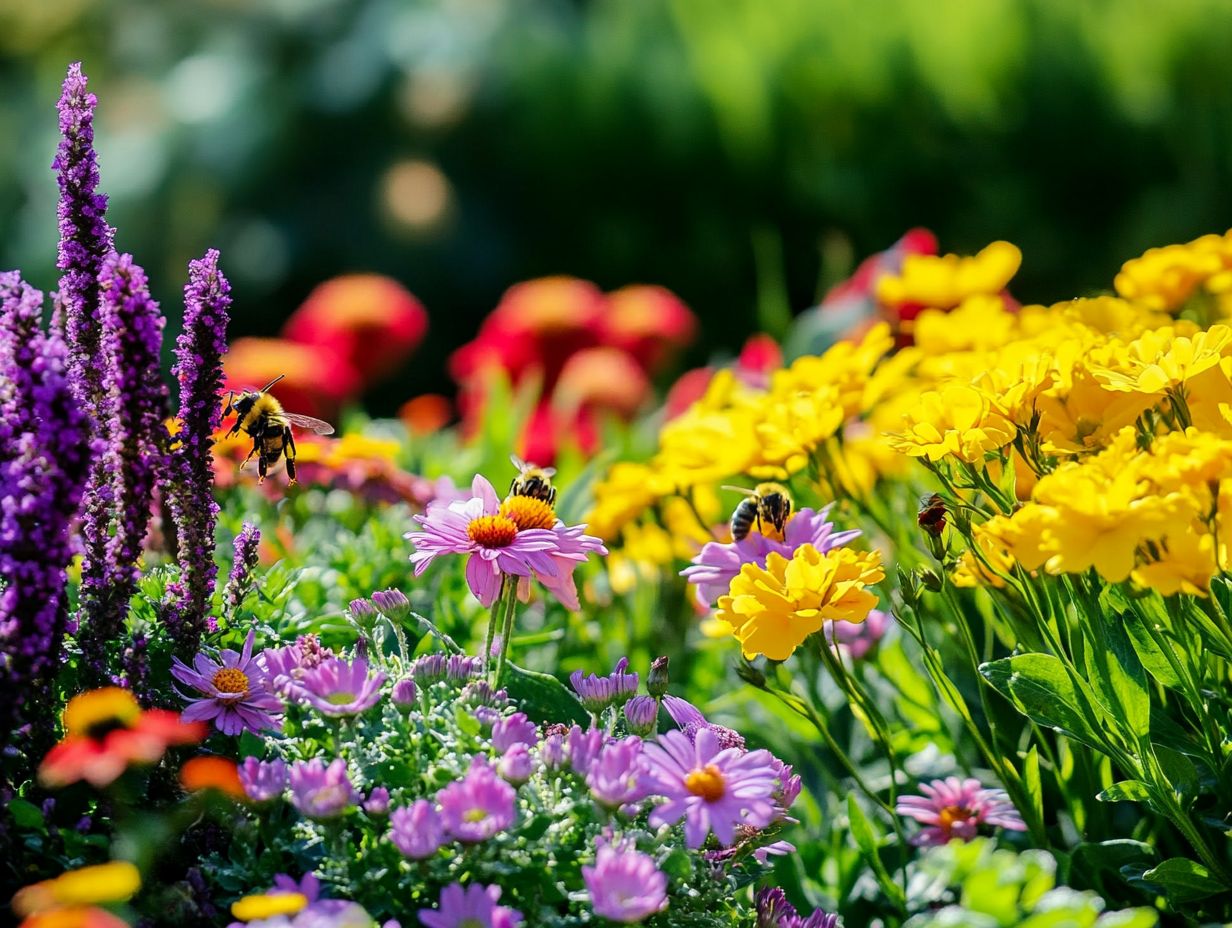
What is bee foraging and why is it important?
Bee foraging is the process by which bees collect nectar and pollen from flowers to make honey and feed their colony. It is crucial because, without foraging, bees cannot survive, and pollination of plants would be negatively affected. However, bee populations face threats from various factors, including pests like Varroa mites, which can significantly impact their health and foraging efficiency.
How can I encourage bee foraging in my garden?
You can encourage bee foraging in your garden by planting a variety of bee-friendly flowers, providing a water source, and avoiding the use of pesticides.
What are some examples of bee-friendly flowers?
Some examples of bee-friendly flowers include lavender, sunflowers, coneflowers, and wildflowers. Bees are attracted to brightly colored flowers with open petals.
Why is it important to provide a water source for bees?
Bees need water to stay hydrated and maintain their hive’s humidity. Providing a shallow dish of water with pebbles or floating objects for bees to land on helps them drink without drowning.
Can I still use pesticides in my garden if I want to encourage bee foraging?
It is best to avoid using pesticides in your garden if you want to encourage bee foraging. Pesticides can harm bees and other beneficial insects, as well as contaminate the nectar and pollen they collect.
Are there any other ways I can support bee foraging besides planting flowers?
Yes, you can create a bee-friendly habitat by leaving some areas of your garden un-mowed, providing nesting sites such as bee houses, and avoiding the use of chemical fertilizers.
Start planting bee-friendly flowers today to help support local bee populations!

